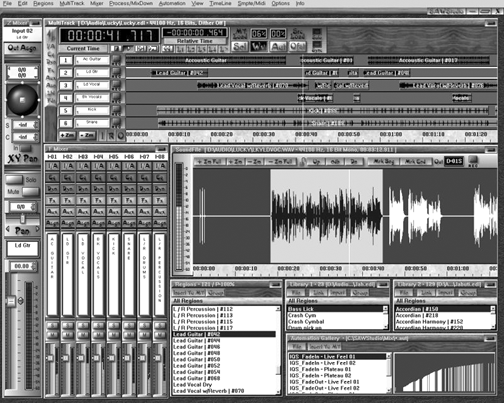
FIRE IT UP
When you first fire up SAW you’ll want to visit the Options menu to assign your sound card and drivers in the Audio Device Setup menu. You’ll also want to use the File Path Setup option to tell SAW where to record audio and find its various files.
Once that’s set you can spend some time exploring the interface. Unlike other audio editors, SAW’s interface doesn’t always follow the tape-recorder paradigm that most editors adhere to. For example, the transport controls don’t include a fast-forward or rewind button, since when you think about it there’s no pressing need for either. We’re not shuttling through tape, and we can click on a location to go there instantly, so who needs ‘em? As a result, SAW’s interface can be daunting at first, but here are some descriptions to help you get comfortable.
There are only about four windows that you’ll use regularly and will need to understand. The largest and most obvious of these is the MultiTrack window, which displays your tracks. The upper left is home to the main counter and the transport buttons. Next to these is the Marked Time indicator that shows the length of a selection, and four locate buttons. To the right of those are four mode buttons for Selection, Waveform, Automation, and Offset, with the latter two being dedicated to mix automation functions. Also here are two indicators that show you the CPU load and the load on disk and RAM access. Below all these are your tracks, which show as waveforms if the Wv button is lit, and as blocks if it’s not.
There’s a little strip on the leftmost edge of the MultiTrack window that is connected to the E Mixer window, which is the strip you’ll generally see on the far left of the screen. See, the E Mixer strip is a complete channel strip that shows all the settings for the currently selected track (known in SAW parlance as the Hot Channel). But the strip is far too long to display on the screen in its complete form, so you can view sections of the E Mixer strip by clicking on the little strip in the MultiTrack window. For example, to see the equalization settings you’d click, the Eq label on the strip, while clicking the Fdr label shows you the fader, pan, mute and solo portion of the strip. You can also right-click on the E Mixer strip to scroll up and down through all the sections, but it’s much quicker to click the labels.
The third important window is the F Mixer, which is simply a smaller, simplified view of the entire mixer. Clicking here on any channel makes it Hot, and it’s then displayed in full in the E Mixer window. Finally, the Library window is a browser that will list all the valid wave files it finds in any directory you choose. Right-clicking on any of these files will cause it to play and display as a waveform in the SoundFile window. This window is brought forward when you double-click on a region in the MultiTrack window, or when you right-click on a file in the Region List or Library window. It will show the file in high detail, but you cannot edit from within it — all editing occurs in the MultiTrack window.
